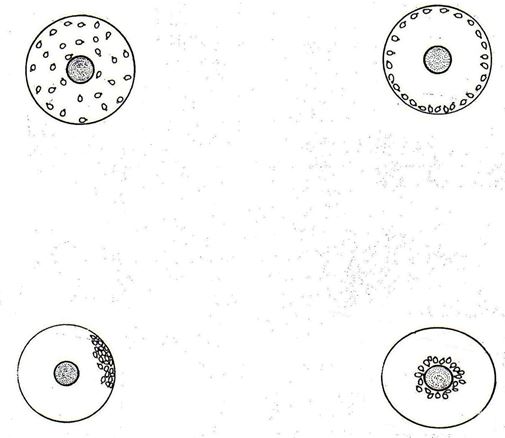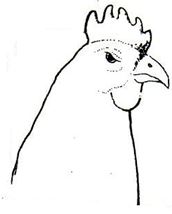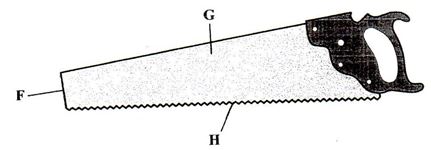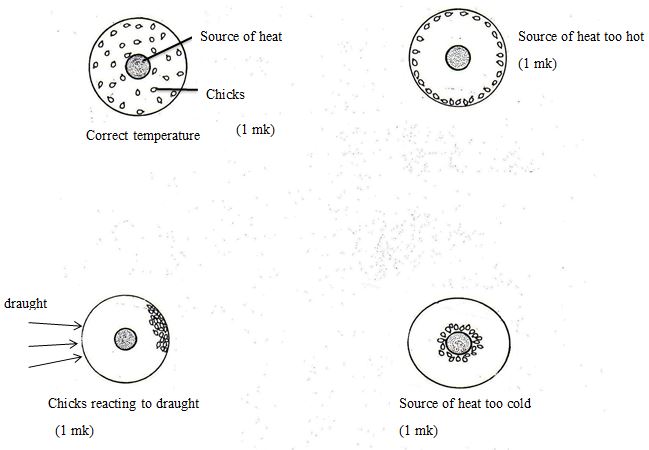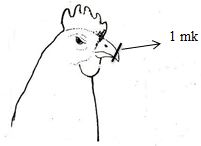Questions
INSTRUCTIONS TO CANDIDATES
- This paper consists of three sections; A, B and C.
- Answer All questions in Section A and B in the spaces provided.
- Answer any two questions in Section C in the spaces provided.
SECTION A
- Name four dairy breeds of goats. (2 mks)
- Outline two control measures of roundworm. (1 mk)
- State four maintenance practice carried on a wheelbarrow. (2 mks)
- Give three ways of transmitting livestock diseases. (1 ½ mks)
- State the appropriate use of each of the following farm tool.
- Stock and die (1 mk)
- Oil stone (1 mk)
- Distinguish between zoonotic disease and a notifiable disease. (2 mks)
- State four reasons for keeping livestock healthy. (2 mks)
-
- What is the intermediate host for liverfluke. (1 mk)
- What is the duration of oestrus cycle in a cow. (1 mk)
- State two advantages of upgrading cattle. (2 mks)
- Give the functions of the following parts of a reciprocating mower.
- swath stick ( ½ mk)
- Shoe ( ½ mk)
- Cutter bar ( ½ mk)
- Give two functions of the albumen in an egg. (2 mks)
- State four qualities of good wool. (2 mks)
- Give two reasons why honey harvesting is discouraged at night. (2 mks)
- Which hormone stimulates milk let down? (1 mk)
- Give two qualities of a creep feed. (2 mks)
- State two reasons for seasoning timber before use in construction. (2 mks)
- Name the causal organisms of the following diseases.
- Anthrax ( ½ mk)
- Nagana ( ½ mk)
SECTION B
- Study the diagram below carefully and answer the questions that follow.
Indicate below each diagram the conditions in the brooder. (4 mks) - Study the diagram below and answer the questions
- Draw a line in the diagram indicating the correct position of debeaking the birds. (1 mk)
- Give the reasons for debeaking birds. (2 mks)
- Below are illustrations of animal hooves and an activity being done?
- What activity is going on in the diagram F? ( ½ mk)
- Which of the above hooves is likely to predispose foot rot infections? ( ½ mk)
- Other than protecting animals from foot rot, give two other reasons for carrying out the above activity. (2 mks)
- The following is an illustration of a handsaw. Study it carefully and answer the questions that follow.
- Name the parts labelled.
- Explain three maintenance practices that should be carried out on the part labelled H. (3 mks)
- The illustrations below represent the different stages of development of a three host tick.
Study it carefully and then answer the questions that follow.- Briefly explain what is happening in the following stages. (2 mks)
1 –
4 –
5 –
7 – - Why could it be difficult to control the above tick using acaricides? (1 mk)
- Name the most common sites the tick can be found on the body of an animal. (2 mks)
- Briefly explain what is happening in the following stages. (2 mks)
SECTION C
-
- Describe the control measures of cannibalism in layers. (10 mks)
- State five maintenance practices of a mould board plough. (5 mks)
- State the advantages of a four stroke engine. (5 mks)
-
- Describe six effects of parasite on livestock (6 mks)
- Explain five reasons for maintaining farm tools and equipment (5 mks)
- Discuss the management of layers in a deep litter system (9 mks)
-
- Explain the practices observed in clean milk production (8 mks)
- Explain the importance of fences in a farm (12 mks)
Marking Scheme
- Four dairy breeds of goats (4x ½ ) 2mks
- Saanem
- Toggenburg
- British alpine
- Anglo Nubian
- Jamnapan
- Control measures of roundworms (2 x ½ )1mk
- Practising rotational grazing and resting the pasture to starve the larvae to death
- Improving sanitation in animal houses by ensuring that the infected dung is cleaned
- All animals should be drenched with appropriate antihelmintics regularly
- Proper use of latrines by the farm works
- Avoid contamination of hay and feed by faeces
- Maintenance practice on wheelbarrow ( ½ x4) 2mks
- Cleaning after
- Oil the wheel axle
- Replace worn out tyre
- Paint the metallic part to prevent rusting
- Three ways of transmitting livestock diseases (3x ½ ) 1 ½ mks
- Through vectors
- Through ingestion of contaminated food and water
- Through inhalation of contaminated air
- Appropriate use of each of the following tools
- Stock and die –for cutting threads on pipe (1x1) 1mk
- Oil stone – used for sharpening other tools (1x1) 1mk
- A zoonotic disease – this is a disease that can be transmitted from livestock to humans and viceversa while notifiable disease is highly contagious disease that spreads very fast whose outbreak must be reported to the relevant authorities. (2mks)
- Reasons for keeping livestock healthy (4 x ½ ) 2mks
- Healthy animals grow faster to reach maturity quickly
- Good health gives animals a longer economic and productive life
- Healthy animals produce good quality products hence high market value
- Healthy animals do not spread diseases to either animals of human beings
- Healthy animals are economical and easy to keep as the farmers spends less money on disease treatment
-
- Intermediate host for liverfluke (1 mk)
- Fresh water snails / mud snail
- Oestrus cycle in a cow (1 mk)
- 21 days
- Intermediate host for liverfluke (1 mk)
- Advantages of upgrading cattle (2x1) 2mks
- Improves low grade livestock
- It is cheaper compared to buying a purebred
- Helps develop breeds that can adopt to harsh environments
- Can be used to introduce desired characteristics in a herd
-
- Functions of a swath stick ( ½ mk)
- Keeps the cut crop or grass falling correctly
- Function of the shoe ( ½ mk)
- Has a runner to absorb the weight and tear
- Function of the cutter bar ( ½ mk)
- Guides fingers of the mower
- Functions of a swath stick ( ½ mk)
- Function of the Albumen (1x2) 2mks
- Provides nutrients to the developing chick
- Cushions small movement of the inner egg contents
- Good quality wool ( ½ x4) 2mks
- Physically clean
- Should be long
- Should be strong
- Should be elastic
- Should be fine
- Should be preferably white in color
- Should have a high fleece weight
- Why honey harvesting is discouraged at night (1x2) 2mks
- It is difficult to distinguish between white combs and dark combs
- There is contamination of harvested honey with brood
- Bees can be crushed because they are not visible in the dark
- Accidental bush fires can break out
- Hormone that stimulate milk let down is Oxytocin hormone (1 mk)
- Qualities of creep feed (1 x 2) 2mks
- Highly digestible
- High in carbohydrate value
- Highly palatable
- Have a high digestible crude protein
- Rich in minerals
- Contains vitamins A, B and D
- Reasons for seasoning timber (1X2) 2mks
- Prevents warping due to uneven expansion and contraction
- Prevents decay due to fungal attack
- Prevents cracking of timber
- Improves durability and strength
- Causal organisms for
- Anthrax - Bacillus anthracis (bacteria) ( ½ mk)
- Nagana - Trypanosoma sp (protozoa) ( ½ mk)
-
-
-
- Reasons for debeaking (2x1) 2 mks
- To control egg eating habit
- To control cannibalism
- To control toe pecking
-
-
- The activity is hoof trimming ( ½ mk)
- Hoof D predisposes hoof to foot rot infection ( ½ mk)
- Reasons for activity (2x1) 2 mks
- For proper walking
- To minimise injuries during service
-
-
- F – Toe (1 mk)
- G – Blade (1 mk)
- Maintenance practices on H (3x1) 3mks
- Sharpening of teeth regularly to improve efficiency
- Regular cleaning after use to remove dirt
- Setting the teeth to maintain cutting angles
- Apply oil before storage to prevent rusting.
-
-
- ( ½ x4) 2mks
- 1 – Egg hatches and larvae emerge
- 4 – nymphs climb onto the 2nd host and feed
- 5 – Engorged nymphs drop down to lay legs
- 7 – Engorged female drop down to lay eggs
- (1 mk) Tick keeps on dropping off the animal at every stage of development so its not affected by acaricides when animal is sprayed.
- (2 x 1) 2 mks
- Ears
- Base of the horns
- Around the eyes
- Tail switch
- ( ½ x4) 2mks
-
- Control measures of cannibalism (10 x 1) 10 mks
- Avoid bright light in the house
- Avoid overcrowding
- Provide balance diet
- Contol external parasites
- Hang vegetables in the house to keep birds busy
- Debeak birds which peck at others
- Cull perpetual cannibals
- Cull birds with prolapse
- Provide adequate equipment feeders, water, perches
- Avoid introduction of new birds in the stock
- maintenance practices of a mouldboard plough (5 x 1) 5mks
- Lubricate the rolling parts e.g the wheel bearings
- Paint scratched parts of the plough
- Sharpen the share or replace if worn out
- Check all lose nuts and bolts and replace where necessary
- Clean the implement after each days work to remove soil, mud and trash
- For long storage, keep under a shed and apply lubricants
- Advantages of four stroke engine (5x1) 5 mks
- Provides high power which can do heavy farm work
- Have efficient fuek and oil utilization
- Perform a wide range of farm operations
- Are effective cooled with water thus allowing the production of large engine sizes
- Exhaust gases are effectively expelled from the cylinders
- Control measures of cannibalism (10 x 1) 10 mks
-
- describe effects of parasites on livestock (6 x 1) 6mks
- Cause anaemia – blood sucking parasites take large volumes of blood from the host animals leading to anaemia.
- Deprive the host animal of food especially the internal parasites, compete for food with the host.
- Injury and damage to tissues and organs e.g. biting parasites break the skin of the animal exposing it to secondary infection
- Disease transmission –some parasite acts as vectors of some diseases
- Cause irritation –some external parasites irritate the animals through their biting
- Obstruction to internal organs – internal parasites may cause mechanical obstruction or blockage of the internal passages leading to mal-functioning of the organs thus affected
- Explain reasons for maintaining farm tools and equipment (5x1) 5mks
- To increase durability
- To reduce the replacement cost
- Increased efficiency
- To avoid injury to the user
- To avoid damage to the tool
- Discuss the management of layers in a deep litter system (1 x 9) 9 mks
- Ensure enough space in the house 0.3 -0.5 m2 per bird
- The litter should be kept dry by regularly raking
- Provide enough perches which should be well spaced in the house
- Provide enough waterers, feeders and well distributed
- Provide clean and adequate water
- Ensure the nest is dark enough to avoid cannibalism
- Collect eggs at least twice a day
- Provide adequate layers mash
- Supply some grit to help in digestion
- Ensure adequate supply of greens for vitamins
- Cull poor layers or diseased birds
- Debeak birds to prevent cannibalism and egg eating
- Vaccinate against prevailing diseases
- Provide grains on the litter to avoid cannibalism
- Isolate and treat sick animals
- describe effects of parasites on livestock (6 x 1) 6mks
-
- Practices observed in clean milk production (1 x8) 8mks
- Keep cows healthy (free from diseases)
- Wash cows flanks, udder using clean water, then dry using milking towels
- The milk man should be clean dressed in a white overall, he/she should have short nails
- Ensure the milking shed is clean at all times, wash after every milking and disinfect regularly
- Clean and sterilize milking utensils and equipment using detergents and disinfectants
- After milking, filter and cool the milk to 40c
- Cover the milk and keep in a cool, dry dust free room or deliver immediately to the milk collection centre
- Do not expose milk to direct sun or store milk in containers having traces of copper or iron since this may lead to oxidation of milk fats.
- Importance of fences in a farm any(6 x 2) 12 mks
- Fences mark boundaries
- They keep out unwanted visitors e.g thieves and wild animals
- Live fences act as windbreaks reducing wind erosion and lodging of weak stem crops e.g. maize
- They separate crop fields from pastures in mixed farming
- They divide pasture lands onto paddocks facilitating paddocking grazing system
- Enhances control of livestock parasites and livestock diseases by restricting movement of livestock
- Fences help to isolate sick animals from the rest of the herd to avoid the spread of diseases
- They enable the farmers to control breeding by rearing different animals in different paddocks
- They provide security to the homestead and farm animals.
- Practices observed in clean milk production (1 x8) 8mks
Download Agriculture Paper 2 Questions and Answers - Asumbi Girls High School KCSE Mock 2021.
Tap Here to Download for 50/-
Get on WhatsApp for 50/-
Why download?
- ✔ To read offline at any time.
- ✔ To Print at your convenience
- ✔ Share Easily with Friends / Students

